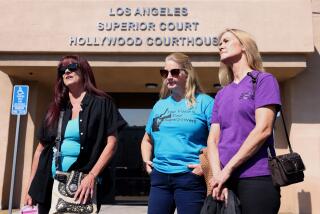Governor Holds Key to Childrenâs Project : Funding for Program That Strives to Curb Abuse Awaits His Signature
For years, Toni thought it was OK to whip her two daughters, clip clothespins onto their tongues and put them in the corner of their room whenever they were bad.
Toni, 33, a single parent in Pasadena, had been abused as a child. Her mother had whipped her with switches, extension cords and, sometimes, razor strops.
âThis is the way I was brought up,â she said. âI was not conscious it was wrong or abusive whatsoever.â
State authorities found out in April that Toni (a pseudonym) was abusing her children and threatened to take them away from her. When she pleaded with them to let her keep the children, the authorities said they would agree if she would enroll in a state-funded program in which a therapist would make regular visits to her house to help her stop abusing the girls.
She agreed, and since then, Toni said, she has not abused her daughters.
âThey seem to enjoy me being home with them,â she said. âIf they had taken my children away from me without giving me this opportunity, I know things would have gone bad.â
Toniâs is one of the success stories made possible by a state pilot project at Hillsides Home for Children in Pasadena, which strives to keep abused children and parents together.
But state funding for Hillsidesâ In-Home Critical Care program, and seven others in California, will continue only if Gov. George Deukmejian approves an appropriation thatâs part of the state budget to extend each centerâs contract for another year.
âFunding from the state ends (in June), which is part of our franticness,â said Sylvia Levitan, director of the Hillsides in-home project. âWe can hang on for another month, but beyond that weâll have to tell our staff to find another job.â
Even if the governor approves the extension, the fate of the project beyond 1990 is unclear.
State funds constitute 75% of Hillsidesâ $200,000 annual budget for its in-home project, which treats 100 San Gabriel Valley families each year and includes four full-time therapists, one part-time social worker and one full-time project director. The remainder of the money comes from the county.
âIt is a temporary project, an innovative situation that was never meant to be a permanent thing,â said Kathleen Norris, director of public affairs for the state Department of Social Services, which monitors the eight programs.
Norris said the state Office of Child Abuse Prevention is evaluating each project and, so far, âthe comments from (the office) have been favorable.â
The project, in its sixth year, has apparently worked well. Levitan said statistics show that the program is 89% successful in preventing further child abuse.
Hillsidesâ in-home therapists become involved in child-abuse cases after an incident is reported to the county Department of Childrenâs Services and childrenâs services workers determine that the child can stay in the home if the parent agrees to undergo therapy.
Levitan said past efforts to help abusive parents by removing the children from the home actually did more harm because siblings often would be separated from each other, âbounced around from relative to relative, and to different foster homes. We all recognize how traumatized theyâve been by the removal.â
Abused After They Return
And when they return home to their parents after a long period of separation, the children are often abused again, Levitan said.
In-home therapists spend 20 hours a week for six weeks in the home, counseling the abusive parent and the spouse, talking with the children, and sometimes using program funds to give financial assistance. Sixty percent of the parents are single mothers, and many are drug addicts and alcoholics, according to Levitan.
Parents who complete the program are encouraged to attend regular group therapy sessions at Hillsides, and therapists often stay in contact with the families after the in-home part of the program is over.
Hillsides also houses and cares for children who have been abused so severely that they must be taken out of the home.
But a growing number of child-abusers can be treated with daily intervention in the home, according to Rosemarie Terbrusch, an in-home therapist at Hillsides. The in-home project treats children who have been sexually abused, beaten or hit, neglected, and very young children who have been force-fed or burned.
âThe Department of Childrenâs Services wants to know that the child is safeâ before allowing Hillsides to start in-home treatment, Terbrusch said. âSometimes that means the perpetrator has to be out of the home or the child removed temporarily.â
Father Able to Return
Rick, an unemployed Arcadia man living with his wife and three children in a small apartment, agreed to move out after the Department of Childrenâs Services learned that he had sexually abused his 15-year-old daughter for years.
But after staying away for more than a year, Rick (not his real name) decided that he wanted to return, enlisted the help of Hillsides and was able to move back with his family.
Rick had structured, regular meetings with his family and a Hillsides therapist for six weeks, and started getting his life in order. He is now looking for a bigger home for his family.
Levitan said Rickâs story strongly indicates that keeping families together is important for the recovery of both the parents and the children.
A Monrovia woman who enrolled in Hillsidesâ program after hitting her boyfriendâs daughter near the eye, agreed.
âIt saved us as a family,â she said. âThe No. 1 important thing was that Rosemarie (the therapist) was right here in the home, having dinner with us, watching us. It brought us a lot closer.â
More to Read
Sign up for Essential California
The most important California stories and recommendations in your inbox every morning.
You may occasionally receive promotional content from the Los Angeles Times.










